The name of this pub is a reminder of Kingston’s royal connections. Seven Saxon kings were crowned in Kingston or, as it was once known, King’s Tun, meaning royal farm or estate.
Illustrations and text about The Kings Tun.
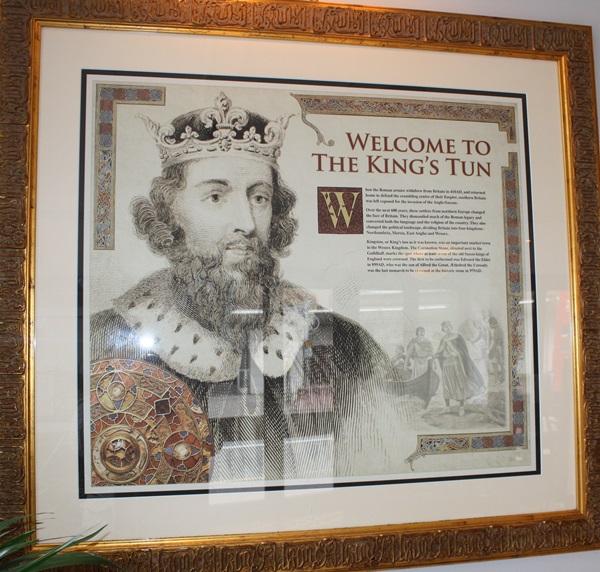
The text reads: When the Roman armies withdrew from Britain in 410AD, and returned home to defend the crumbling centre of their Empire, southern Britain was left exposed for the invasion of the Anglo-Saxons.
Over the next 600 years, these settlers from Northern Europe changed the face of Britain. They dismantled much of the Roman legacy and converted both the language and the religion of the country. They also changed the political landscape, dividing Britain into four kingdoms - Northumbria, Mercia, East Anglia and Wessex.
Kingston, or King’s tun as it was known, was an important market town in the Wessex Kingdom. The Coronation Stone, situated next to the Guildhall, marks the spot where at least seven of the old Saxon kings of England were crowned. The first to be enthroned was Edward the Elder in 899AD, who was the son of Alfred the Great. Ethelred the Unready was the last monarch to be crowned at the historic stone in 979AD.
An illustration and text about William Daniel.
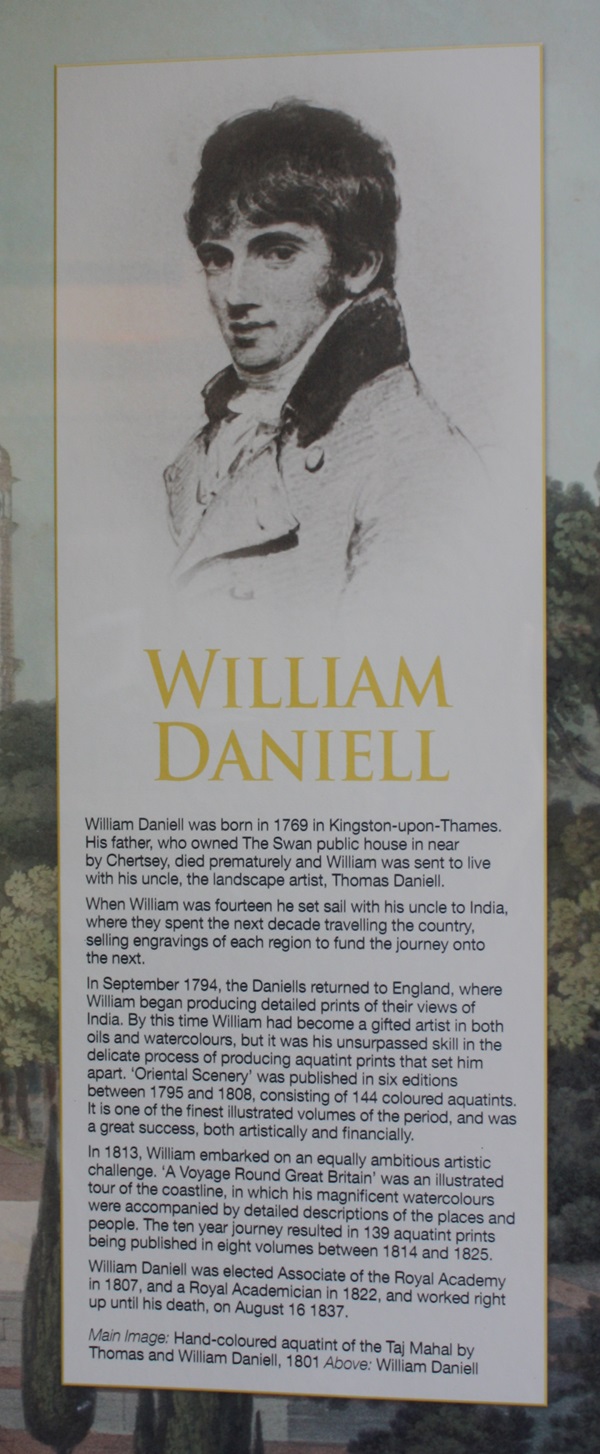
The text reads: William Daniell was born in 1769 in Kingston upon Thames. His father, who owned The Swan public house in nearby Chertsey, died prematurely and William was sent to live with his uncle, the landscape artist, Thomas Daniell.
When William was fourteen he set sail with his uncle to India, where they spent the next decade travelling the country, selling engravings of each region to fund the journey onto the next.
In September 1794, the Daniells returned to England, where William began producing detailed prints of their views of India. By this time William had become a gifted artist in both oils and watercolours, but it was his unsurpassed skill in the delicate process of producing aquatint prints that set him apart. ‘Oriental Scenery’ was published in six editions between 1795 and 1808, consisting of 144 coloured aquatints. It is one of the finest illustrated volumes of the period, and was a great success, both artistically and financially.
In 1813, William embarked on an equally ambitious artistic challenge. ‘A Voyage Round Great Britain’ was an illustrated tour of the coastline, in which his magnificent watercolours were accompanied by detailed descriptions of the places and people. The ten year journey resulted in 139 aquatint prints being published in eight volumes between 1814 and 1825.
William Daniell was elected Associate of the Royal Academy in 1807, and a Royal Academician in 1822, and worked right up until his death, on August 16 1837.
Above: William Daniell.
Photographs, print and text about Marble Hill House and Henrietta Howard.
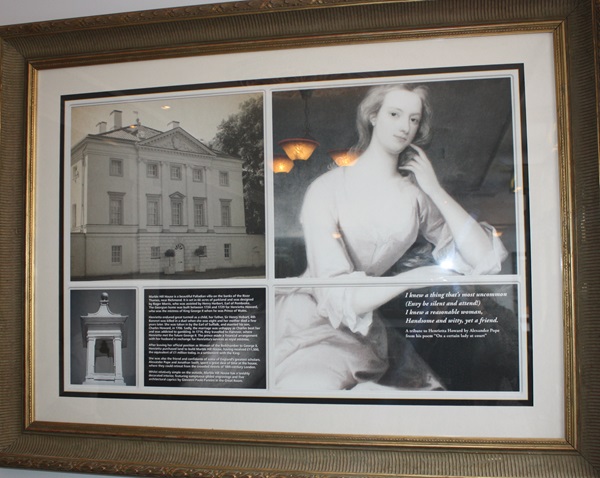
The text reads: Marble Hill House is a beautiful Palladian villa on the banks of the River Thames, near Richmond. It is set in 66 acres of parkland and was designed by Roger Morris, who was assisted by Henry Herbert, Earl of Pembroke. The Georgian home was built between 1724 and 1729 for Henrietta Howard, who was the mistress of King George II when he was Prince of Wales.
Henrietta endured great turmoil as a child, her father, Sir Henry Hobart, 4th Baronet was killed in a duel when she was eight and her mother died a few years later. She was taken in by the Earl of Suffolk, and married his son, Charles Howard, in 1706. Sadly, the marriage was unhappy as Charles beat her and was addicted to gambling. In 1714, they travelled to Hanover, where Henrietta met the future George II. The prince made a financial arrangement with her husband in exchange for Henrietta’s services as royal mistress.
After leaving her official position as Woman of the Bedchamber to George II, Henrietta purchased land to buy Marble Hill House, having received £11,500, the equivalent of £1 million today, in a settlement with the king.
She was also the friend and confidante of some of England’s greatest scholars. Alexander Pope and Jonathan Swift, spent a great deal of time at the house, where they could retreat from the crowded streets of 18th century London.
Whilst relatively simple on the outside, Marble Hill House has a lavishly decorated interior, featuring sumptuous gilded engravings and five architectural capricci by Giovanni Paolo Pannini in the Great Room.
A print and text about Sir John Everett Millais.
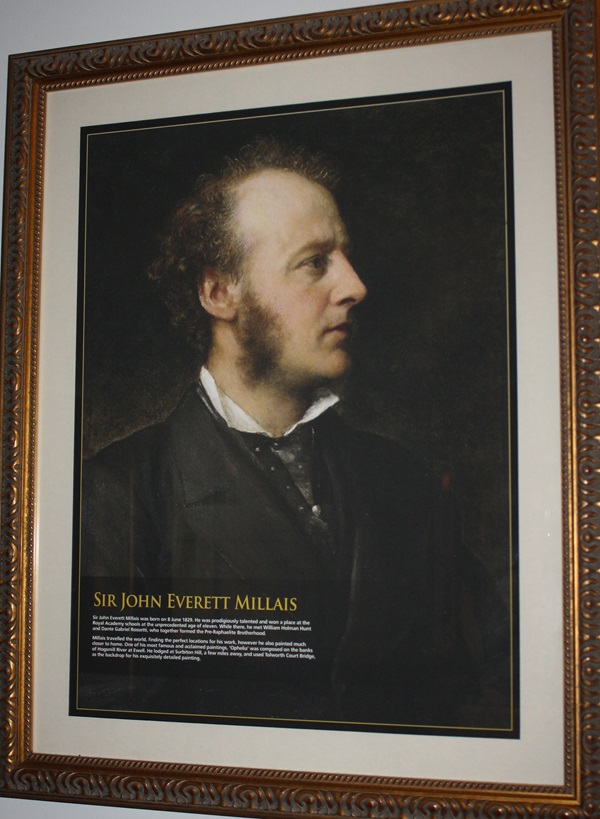
The text reads: Sir John Everett Millais was born on 8 June 1829. He was prodigiously talented and won a place at the Royal Academy Schools at the unprecedented age of eleven. While there, he met William Holman Hunt and Dante Gabriel Rossetti, who together formed the Pre-Raphaelite Brotherhood.
Millais travelled the world, finding the perfect locations for his work, however he also painted much closer to home. One of his most famous and acclaimed paintings, ‘Ophelia’ was composed on the banks of Hogsmill River at Ewell. He lodged at Surbiton Hill, a few miles away, and used Tolworth Court Bridge, as the backdrop for his exquisitely detailed painting.
Photographs and text about Sir John Black.
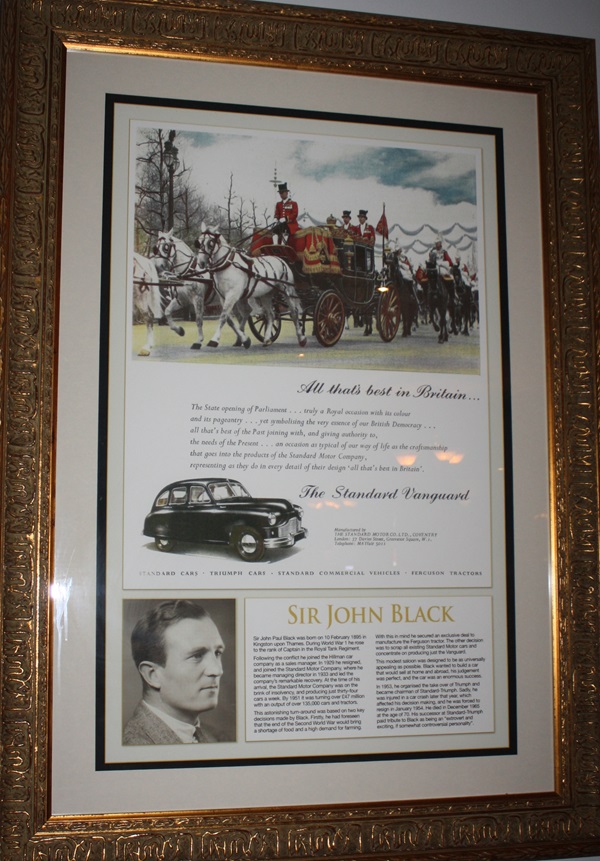
The text reads: Sir John Black was born on 10 February 1895 in Kingston upon Thames. During World War 1 he rose to the rank of Captain in the Royal Tank Regiment.
Following the conflict he joined the Hillman car company as a sales manager. In 1929 he resigned, and joined the Standard Motor Company, where he became managing director in 1933 and led the company’s remarkable recovery. At the time of his arrival, the Standard Motor Company was on the brink of insolvency, and producing just 34 cars a week. By 1951 it was turning over £47 million with an output of over 135,000 cars and tractors.
The astonishing turn-around was based on two key decisions made by Black. Firstly, he had foreseen that the end of the Second World War would bring a shortage of food and a high demand for farming. With this in mind he secured an exclusive deal to manufacture the Ferguson tractor. The other decision was to scrap all existing Standard Motor cars and concentrate on producing just the Vanguard.
This modest saloon was designed to be as universally appealing as possible. Black wanted to build a car that would sell at home and abroad, his judgement was perfect, and the car was an enormous success.
In 1953, he organised the takeover of Triumph and became chairman of Standard-Triumph. Sadly, he was injured in a car crash later that year, which affected his decision making, and he was forced to resign in January 1954. He died in December 1965 at the age of 70. His successor at Stand-Triumph paid tribute to Black as being an “extrovert and exciting, if somewhat controversial personality”.
Photographs and text about Eadweard Muybridge.
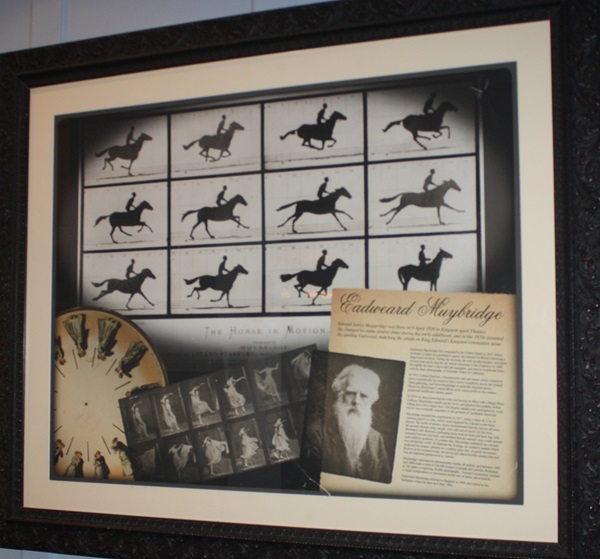
The text reads: Edward James Muggeridge was born on 9 April 1830 in Kingston upon Thames. He changed his name several times during his early adulthood, and in the 1870s assumed the spelling Eadweard, matching the plinth on King Edward’s Kingston coronation stone.
Eadweard Muybridge first emigrated to the United States in 1855, where he began a career as a publisher’s agent, but returned to Britain following a stagecoach accident. During his recovery, he took up photography and spent several years perfecting his art, before returning to San Francisco in 1866. He rapidly became a successful photographer, and shot to worldwide fame with his large photographers of Yosemite Valley in California.
In 1872, Leland Stanford, a businessman and race-horse owner, wanted to prove scientifically his assertion that a horse completely leaves the ground when galloping, and hired Muybridge to settle the disputed theory. However, Muybridge’s initial efforts were unsuccessful as his camera possessed insufficient shutter speed.
In 1874, he discovered that his wife was having an affair with a Major Harry Larkyns. Muybridge sought out her lover, and greeted him politely, before killing him with a single shot. The lengthy murder trial interrupted his work, but he was eventually acquitted on the grounds of ‘justifiable homicide’.
Muybridge resumed his experiments in 1877, using a chain of 12 to 24 cameras placed in a line, which were triggered by a thread as the horse passed. The series of photos clearly demonstrated that the hooves all leave the ground, though many people were still unconvinced. At this time, illustrators still depicted a galloping horse with its front and back legs fully extended forward and back, and doubted that the animal’s legs could assume such unlikely positions. To counter this, Muybridge embarked on a lecture tour around the world. To illustrate his findings, he created a lantern which projected his images, printed on a rotating glass disc, in quick succession. Known as his zoopraxiscope, the device pre-dated flexible camera film and was an important predecessor to cinema.
Muybridge continued his photographic studies of motion, and between 1883 and 1886 made a total of 100,000 images of people and animals. Published as 781 plates comprising 20,000 photographs. ‘Animal Locomotion’ formed a visual compendium of movement for the use of artists and scientists.
Eadweard Muybridge returned to England in 1894, and retired to his birthplace where he died on 8 May 1904.
Illustrations and text about Enid Blyton.
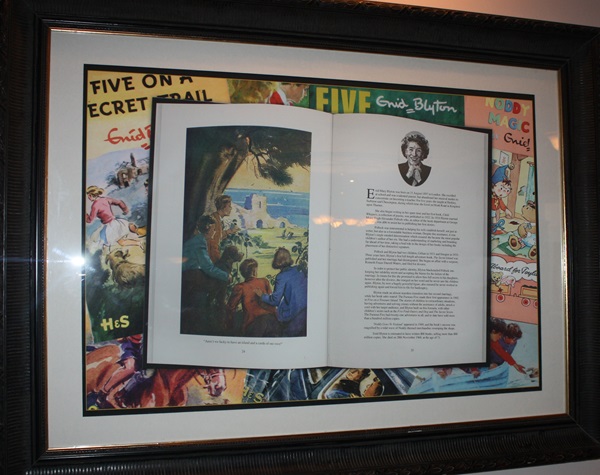
The text reads: Enid Blyton was born on 11 August 1897 in London. She excelled at school and was a talented pianist, but abandoned her musical studies to concentrate on becoming a teacher. For five years she taught at Bickley, Surbiton and Chessington, during which time she lived on Hook Road in Kingston upon Thames.
She also began writing in her spare time and her first book, Child Whispers, a collection of poems, was published in 1922. In 1924 Blyton married Major Hugh Alexander Pollock who, as an editor of the book department at George Newnes, was able to assist her in publishing her first stories.
Pollock was instrumental in helping his wife establish herself, not just as a writer, but also as a formidable business woman. Despite this assistance, it was Blyton’s single minded determination which ensured she became the most popular children’s author of her era. She had an understanding of marketing and branding far ahead of her time, taking a lead role in the design of her books including the placement of her distinctive signature.
Pollock and Blyton had two children, Gillian in 1931 and Imogen in 1935. Three years later, Blyton’s first full-length adventure book, The Secret Island was published and her marriage had disintegrated. She began an affair with a surgeon, Kenneth Fraser Darrell Waters, and filed for divorce.
In order to protect her public identity, Blyton blackmailed Pollock into keeping her infidelity a secret and accepting the blame for the failure of the marriage. In return for this she promised to allow him full access to his daughters, however after the divorce, she reneged on her word and he never saw his children again. Blyton, by now a hugely powerful figure, also ensured he never worked in publishing again and forced him to file for bankruptcy.
Blyton made an almost seamless transition into her second marriage, while her book sales soared. The Famous Five made their first appearance in 1942 in Five on a Treasure Island. The stories of children in extraordinary situations, having adventures and solving crimes without the assistance of adults, struck a cord with her target audience, and Blyton built on this formula, with other children’s series such as the Five Find-Outers and Dog and The Secret Seven. The Famous Five had twenty-one adventures in all, and to date have sold more than a hundred million copies.
Noddy Goes to Toyland appeared in 1949, and the book’s success was magnified by a tidal wave of Noddy-themed merchandise swamping the shops.
Enid Blyton is estimated to have written 800 books, selling more than 600 million copies. She died on 28 November 1968, at the age of 71.
Prints and text about Eric Clapton.
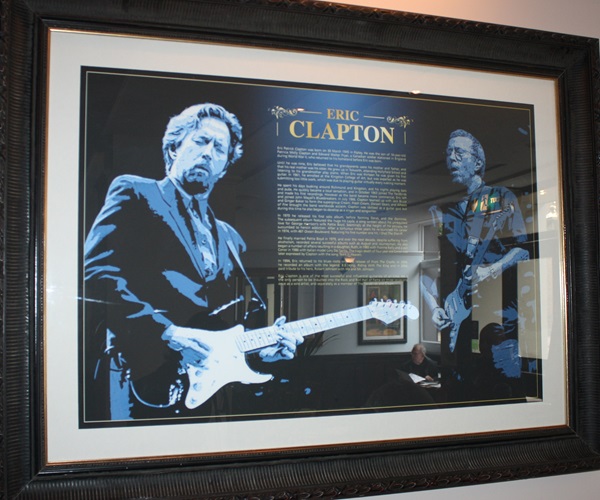
The text reads: Eric Clapton was born on 30 March 1945 in Ripley. He was the son of 16 year old Patricia Molly Clapton and Edward Walter Fryer, a Canadian soldier stationed in England during World War II, who returned to his homeland before Eric was born.
Until he was nine, Eric believed that his grandparents were his mother and father, and that his real mother was his sister. He grew up in Tolworth, attending Hollyfield School and listening to his grandmother playing piano. When Eric was thirteen he was given his first guitar. In 1961, he enrolled at the Kingston College of Art, but was expelled as he was submitting too little work, which was due to playing guitar virtually every waking moment.
He spent his days busking around Richmond and Kingston, and his nights playing bars and pubs. He quickly became a local sensation, and in October 1963 joined The Yardbirds and made his first recordings. However as the band became more commercial, Eric left and joined John Mayall’s Bluesbreakers. In July 1966, Clapton teamed up with Jack Bruce and Ginger Baker to form the supergroup Cream. Fresh Cream, Disraeli Gears, and Wheels of Fire brought the band worldwide acclaim. Clapton was idolised as a guitar god but during this time he also began to develop as a singer and songwriter.
In 1970 he released his first solo album, before forming Derek and the Dominos. The subsequent album featured the huge hit Layla, a song written about his unrequited love for George Harrison’s wife Pattie Boyd. Seemingly at the height of his powers, he succumbed to heroin addiction. After a torturous three years he re-launched his career in 1974, with 461 Ocean Boulevard, featuring his first number one hit, I Shot the Sherriff.
He finally married Pattie Boyd in 1979, and over the next decade, despite suffering from alcoholism, recorded several successful albums such as August and Journeyman. He also began a number of affairs resulting in a daughter, Ruth, in 1985 with Yvonne Kelly and a son, Conor in 1986 with Italian model Lory Del Santo. The tragic death of 4 year old Conor was later expressed by Clapton with the song Tears in Heaven.
In 1994, Eric returned to his blues roots with the release of From The Cradle. In 2000 he recorded an album with the legend BB King, Riding With The King and in 2004, paid tribute to his hero, Robert Johnson with Me and Mr. Johnson.
Eric Clapton is one of the most successful and influential guitarists of all time. He is the only person to be inducted in to the Rock and Roll Hall of Fame on three occasions, once as a solo artist, and separately as a member of The Yardbirds and Cream.
Photographs and text about Decca.
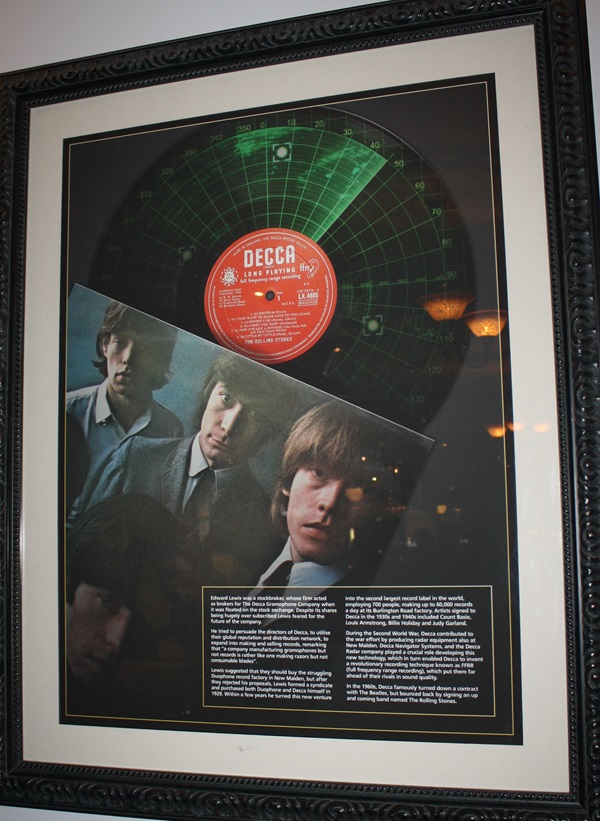
The text reads: Edward Lewis was a stockbroker, whose firm acted as brokers for The Decca Gramophone Company when it was floated on the stock exchange. Despite its shares being hugely oversubscribed Lewis feared for the future of the company.
He tried to persuade the directors of Decca, to utilise their global reputation and distribution network, to expand into making and selling records, remarking that “a company manufacturing gramophones but not records is rather like making razors but not consumable blades”.
Lewis suggested that they should buy the struggling Duophone record factory in New Malden, but after they rejected his proposals, Lewis formed a syndicate and purchased both Duophone and Decca himself in 1929. Within a few years he turned this new venture into the second largest record label in the world, employing 700 people, making up to 60,000 records a day at its Burlington Road factory. Artists signed to Decca in the 1930s and 1940s included Count Basie, Louis Armstrong, Billie Holliday and Judy Garland.
During the Second World War, Decca contributed to the war effort by producing radar equipment also at New Malden. Decca Navigator Systems, and the Decca Radar company played a crucial role developing this new technology, which in turn enabled Decca to invent a revolutionary recording technique known as FFRR (full frequency range recording), which put them far ahead of their rivals in sound quality.
In the 1960s, Decca famously turned down a contract with The Beatles, but bounced back by signing an up and coming band named The Rolling Stones.
A photograph and text about Sir Terrance Conran.
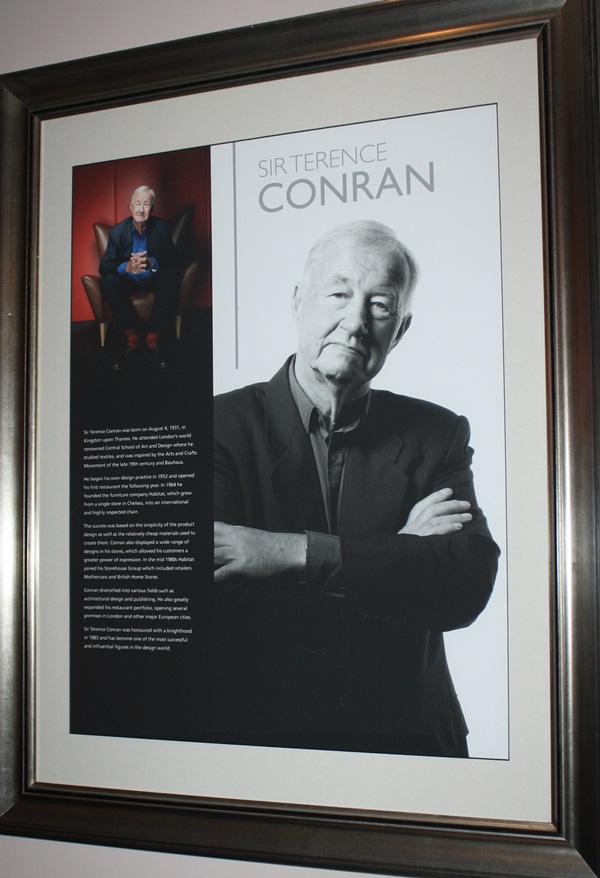
The text reads: Sir Terence Conran was born on August 4, 1931, in Kingston upon Thames. He attended London’s world renowned Central School of Art and Design where he studied textiles, and was inspired by the Arts and Crafts Movement of the late 19th century and Bauhaus.
He began his own design practice in 1952 and opened his first restaurant the following year. In 1964 he founded the furniture company Habitat, which grew from a single store in Chelsea, into an international and highly respected chain.
The success was based on the simplicity of the product design as well as the relatively cheap materials used to create them. Conran also displayed a wide range of designs in his stores, which allowed his customers a greater power of expression. In the mid 1980s Habitat joined his Storehouse Group which included retailers Mothercare and British Home Stores.
Conran diversified into various fields such as architectural design and publishing. He also greatly expanded his restaurant portfolio, opening several premises in London and other major European cities.
Sir Terrence Conran was honoured with a knighthood in 1983 and became one of the most successful and influential figures in the design world.
Photographs and text about John Cooper.
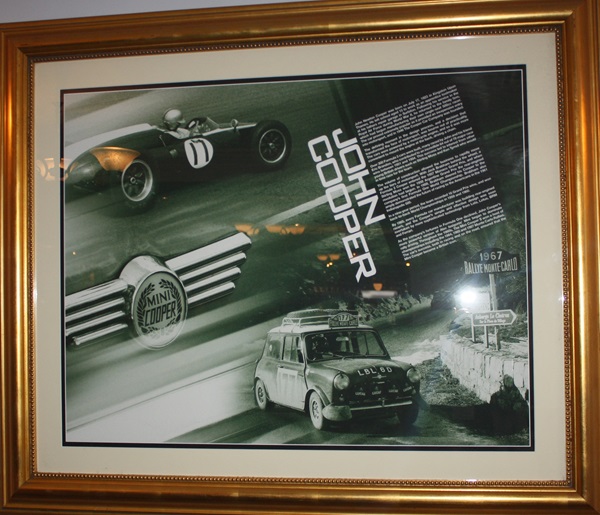
The text reads: John Newton Cooper was born on July 17, 1923 in Kingston Upon Thames. He left school aged 15 to work as an apprentice toolmaker at his father’s repair garage in Surbiton. Following his service in the Royal Air Force during World War II, he returned to the family firm, which had begun manufacturing their own single-seat 500cc racer. The car proved extremely popular as it provided an inexpensive entry into motorsport, and in 1946 The Cooper Car Company was founded.
The defining moment in the design process, and a decision that transformed the face of motorsport, was bourne out of practicality. The cars were powered by a motorcycle engine, and so it was more convenient to mount the engine at the back, driving a chain.
Over 300 Formula 3 cars were built, many raced by John and his friend Eric Brandon, who contributed to an incredible 64 out of 78 major race wins between 1951 and 1954. The success led to interest from other young British drivers such as Stirling Moss and Ken Tyrrell who would in time race for the team.
The volume of construction allowed the business to rapidly move up the tiers of motorsport. With Jack Brabham behind the wheel, a Formula 2 Cooper entered the 1957 Monaco Grand Prix, and when Stirling Moss won the 1958 Argentine Grand Prix, the rear-engined revolution had begun. In 1959, Brabham steered his Cooper to the company’s first Formula One World Championships. Brabham also amply demonstrated the future of racing to the American in the 1961 Indianapolis 500.
In a nine year period, the team recorded 16 Grand Prix wins, and won back-to-back World Championships in 1959 and 1960.
By 1965, every Formula car manufacturer was building rear-engined racers, and the Cooper’s simple and effective design was soon overtaken by more sophisticated technology from Lola, Lotus, BRM and Ferrari.
As the company’s fortunes in Formula One declined, John Cooper’s more powerful version of Alec Issigonis’ Mini began to dominate rally driving. Throughout the 1960s, The Mini Cooper S won a host of championships including the 1964, 1965 and 1967 Monte Carlo Rallies. The car’s success, both in racing and on the road, ensured that the Mini Cooper became a British icon.
A photograph and text about Kingston Market Place.
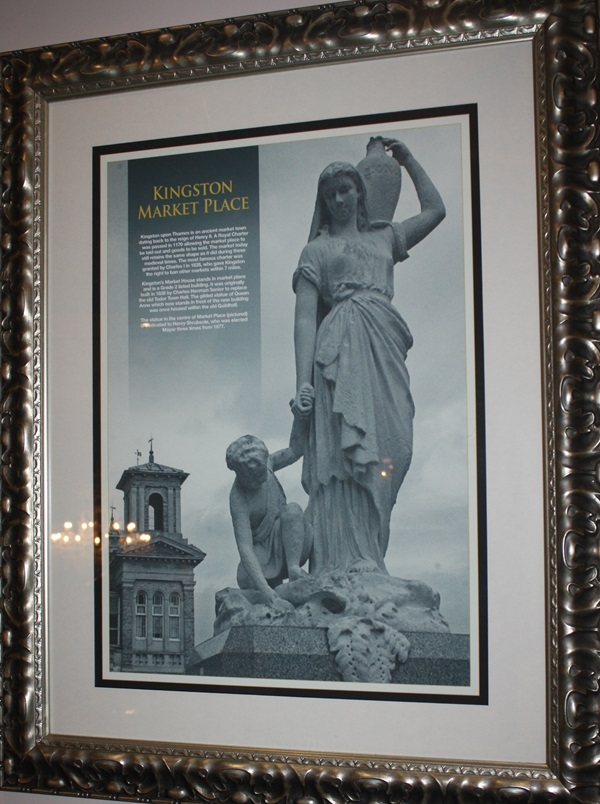
The text reads: Kingston upon Thames is an ancient market town dating back to the reign of Henry II. A Royal Charter was passed in 1170 allowing the market place to be laid out and goods to be sold. The market today still retains the same shape as it did during these medieval times. The most famous charter was granted by Charles I in 1628, who gave Kingston the right to ban other markets within 7 miles.
Kingston’s Market House stands in market place and is a Grade 2 listed building. It was originally built in 1838 by Charles Henman Senior to replace the old Tudor Town Hall. The gilded statue of Queen Anne which now stands in front of the new building was once housed within the old Guildhall.
The statue in the centre of Market Place (pictured) is dedicated to Henry Shrubsole, who was elected Mayor three times from 1877.
A photograph and text about All Saints Church.
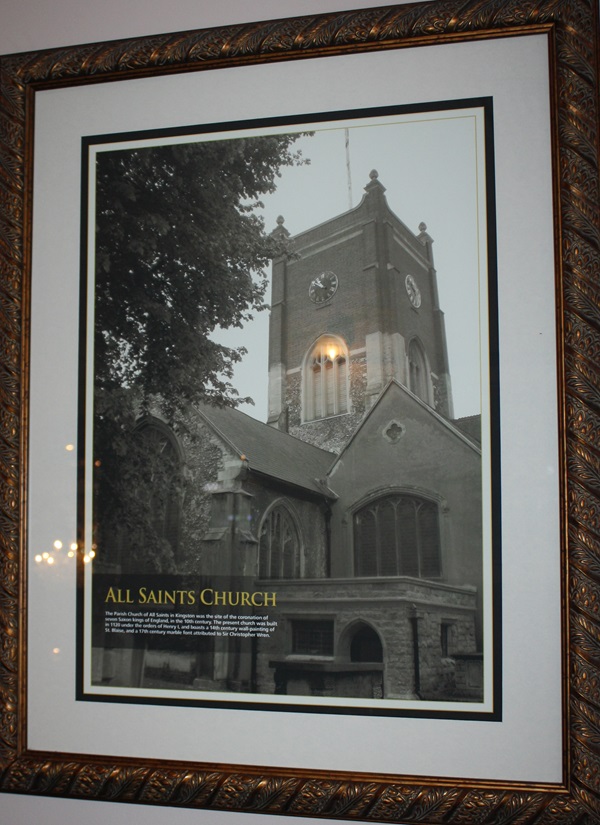
The text reads: The Parish Church of All Saints in Kingston was the site of the coronation of seven Saxon kings of England, in the 10th century. The present church was built in 1120 under the orders of Henry I, and boasts a 14th century wall-painting of St. Blaise, and a 17th century marble font attributed to Sir Christopher Wren.
A photograph of London Road, Kingston-on-Thames, c1910.
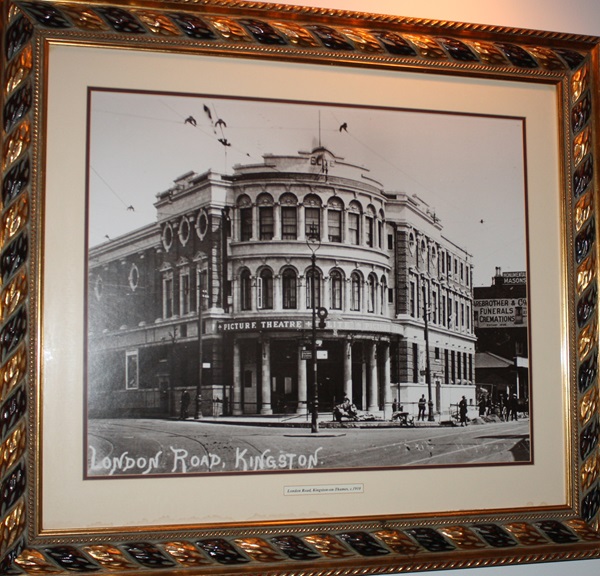
A photograph of Royal County Theatre, Kingston-on-Thames, c1910.
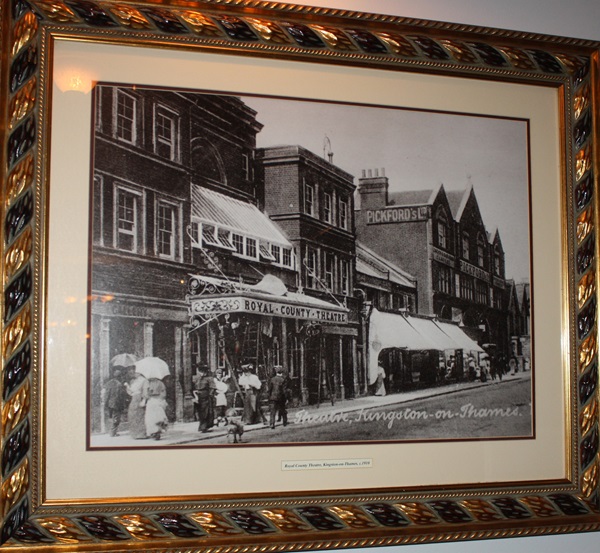
A photograph of Fife Road, Kingston-on-Thames, c1910.
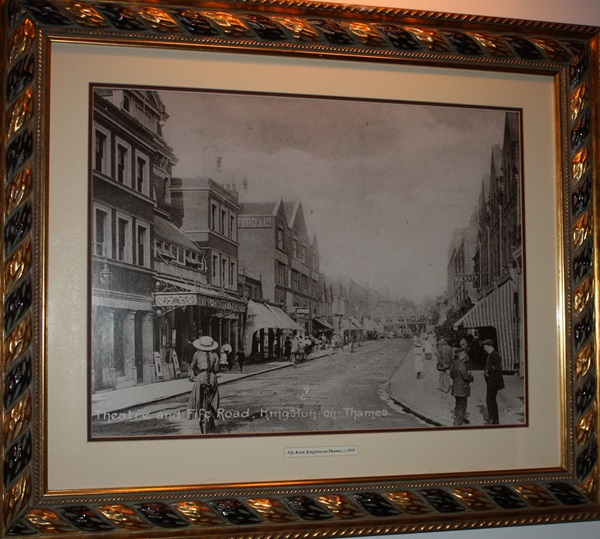
External photograph of the building – main entrance.
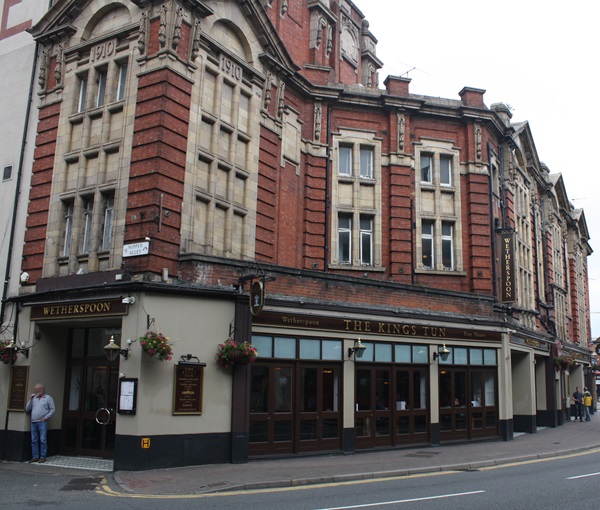
If you have information on the history of this pub, then we’d like you to share it with us. Please e-mail all information to: pubhistories@jdwetherspoon.co.uk